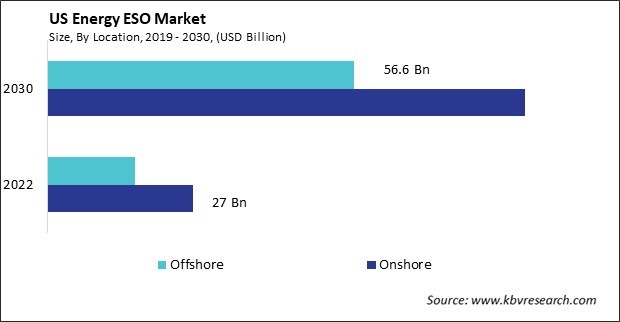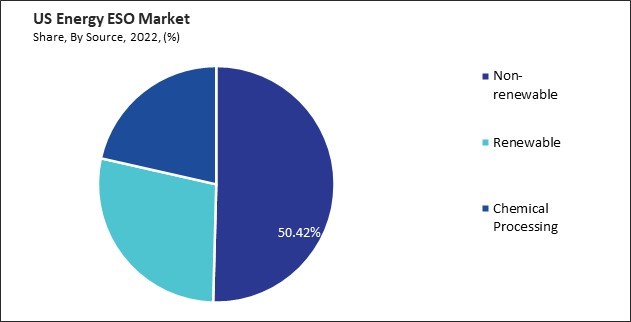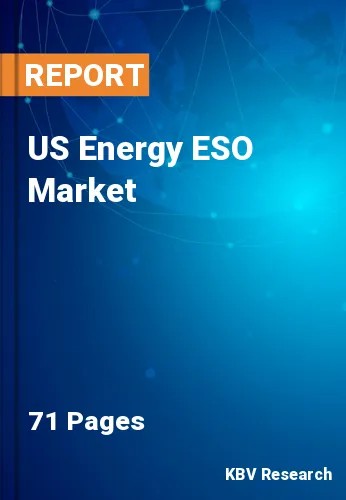The USA Energy ESO Market size is expected to reach $144.8 billion by 2030, rising at a market growth of 16.4% CAGR during the forecast period.
The energy ESO market in the United States is undergoing a transformative evolution driven by the imperative for energy efficiency, grid resilience, and sustainability. This dynamic industry is characterized by a convergence of technological innovation, regulatory support, and a growing awareness of the need for comprehensive energy management solutions. Energy efficiency remains a primary driver in the U.S. energy ESO market, fueled by the dual goals of cost savings and environmental sustainability. Businesses and utilities increasingly recognize optimizing energy consumption's economic and environmental benefits. Energy efficiency measures, ranging from demand response programs to comprehensive energy management systems, are gaining prominence as firms seek to enhance operational efficiency.

Government policies and support mechanisms play a crucial role in driving the growth of the ESO market in the United States. At federal and state levels, energy storage is recognized for achieving broader energy goals, enhancing grid resilience, and facilitating the transition to a cleaner energy future. Incentives, tax credits, and regulatory frameworks are being put in place to encourage utilities, businesses, and other stakeholders to invest in and deploy energy storage optimization solutions.
As the U.S. energy ESO market continues to mature, the anticipated realization of economies of scale is poised to play a pivotal role in cost reduction. This cost-effectiveness is expected to enhance the accessibility of energy storage optimization solutions, making them more widely available for a broader range of applications. This trend aligns with the overarching goal of achieving a more sustainable and resilient energy infrastructure in the United States, with energy ESO technologies contributing significantly to grid stability and renewable energy integration. The energy ESO market is adapting to accommodate the intermittent nature of renewables, offering grid operators and businesses the tools to integrate and manage renewable energy resources effectively. The push towards a cleaner energy mix in the U.S. aligns with national and global sustainability objectives, influencing the direction of energy ESO strategies.
According to the U.S. Energy Information Administration, in 2022, renewable energy provided about 13%, or 13.18 quadrillion British thermal units (Btu), of total U.S. energy consumption. In 2022, the electric power sector reported about 61% of total U.S. renewable energy consumption, and about 21% of total U.S. electricity generation was from renewable energy sources.
Demand response (DR) programs are becoming increasingly crucial in the U.S. energy ESO market, significantly contributing to grid efficiency, reliability, and sustainability. A key trend is the growing prominence of these programs, addressing peak demand challenges and integrating renewable energy sources. Utilities utilize demand response to balance the grid, particularly during peak hours, optimizing overall system efficiency and preventing grid failures. Consumers benefit from financial incentives, such as reduced electricity costs, making participation economically attractive.
The evolving role of demand response is evident in its integration with the U.S. energy ESO market, going beyond traditional methods by incorporating energy optimization strategies like load forecasting and predictive analytics. Government support and regulatory frameworks play a significant role in fostering the growth of the DR program. Federal and state initiatives encourage demand response adoption as part of broader energy efficiency and grid modernization efforts. Incentives, mandates, and regulatory structures create an environment conducive to expanding and optimizing demand response initiatives. Thus, the increasing importance of demand response programs in the U.S. energy ESO market, driven by their role in addressing peak demand challenges and integrating renewables, underscores a pivotal trend.
The U.S. energy ESO market is undergoing a transformative shift in business models, driven by changing customer expectations, technological advancements, and the move towards a resilient energy landscape. A notable trend is the emergence of Energy-as-a-Service (EaaS), enabling businesses to access energy optimization services without significant upfront investments. EaaS providers offer comprehensive solutions, lowering barriers for businesses and fostering collaborative relationships with aligned financial incentives.
Data analytics and advanced technologies like AI and ML are increasingly integrated into business models in the United States, allowing real-time analysis of vast datasets for accurate predictions, efficiency identification, and energy consumption optimization. These technologies enhance the intelligence and effectiveness of energy ESO solutions, providing clients with actionable insights and greater control.
Strategic partnerships play a pivotal role as energy ESO providers collaborate with technology companies, utilities, and stakeholders, creating comprehensive solutions in the U.S. that extend beyond traditional boundaries. These alliances promote innovation and ensure a holistic approach to energy management. Therefore, the transformative shift in the U.S. energy ESO market, marked by the rise of EaaS, integration of advanced technologies, and strategic partnerships, reflects a dynamic response to evolving customer needs and a resilient energy landscape.

The energy ESO market in the United States is characterized by robust competition driven by the imperative to address energy efficiency, grid reliability, and sustainability. Various players, from established utilities to innovative technology companies, are vying for prominence in this dynamic landscape. Major utilities and energy ESO providers, including industry giants like Duke Energy, Pacific Gas and Electric (PG&E), and Dominion Energy, are at the forefront of the competition. These established players leverage their extensive infrastructure, industry expertise, and diversified service portfolios to offer comprehensive energy ESO solutions. Technology companies specializing in energy management and optimization solutions also contribute to the competitive dynamics of the U.S. energy ESO market. Companies such as Schneider Electric, Siemens, and Honeywell are recognized for their advanced energy management systems, IoT-enabled devices, and data analytics platforms.
Companies like Enbala, EnerNOC, and CPower Energy Management are notable, offering specialized Demand Response and energy ESO solutions that cater to specific industry verticals or technological niches. The role of energy aggregators in the competition landscape is also noteworthy. Aggregators act as intermediaries between end-users and grid operators, enabling the participation of distributed energy resources (DERs) in energy ESO programs. Companies like Advanced Microgrid Solutions and Limejump are pivotal in optimizing and monetizing DERs, contributing to grid flexibility and reliability.
ESCOs, such as Ameresco and Johnson Controls, provide comprehensive energy solutions, including efficiency upgrades, infrastructure improvements, and demand response services in the U.S. Their comprehensive approach positions them as key players in the competitive energy ESO market, offering end-to-end solutions to diverse clients. Utilities often collaborate with technology companies, startups, and service providers to enhance energy ESO offerings. For instance, partnerships between utilities like Con Edison and technology companies like Google Nest illustrate the synergy between traditional energy providers and cutting-edge technology solutions, creating a more holistic approach to energy optimization.
By Location
By Source
By Service
Our team of dedicated experts can provide you with attractive expansion opportunities for your business.

